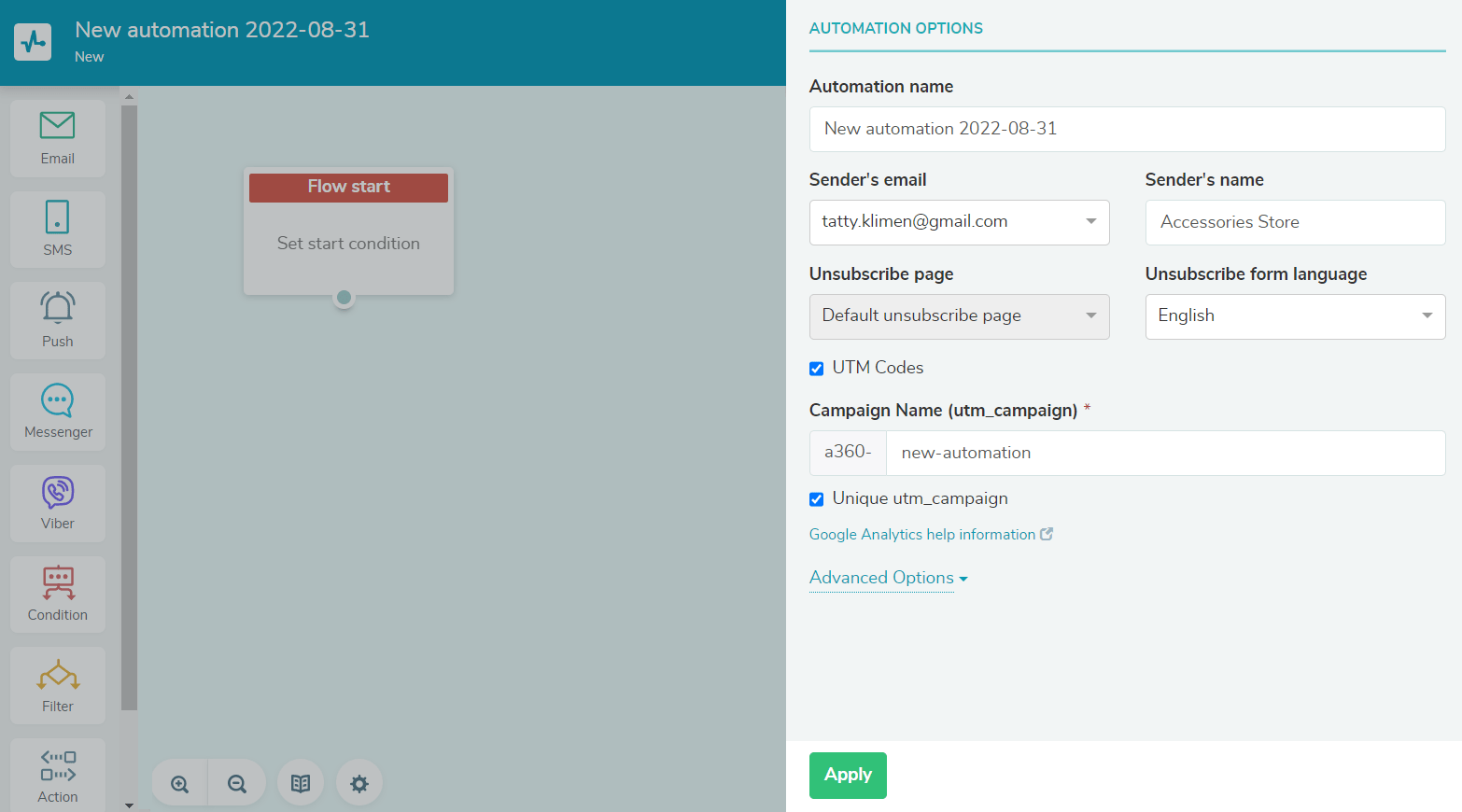How to create an automation triggered by an event
With SendPulse, you can create an automation triggered by an event. Process customer data using various elements, and inform your customers about an abandoned cart, registration on the site, or purchase through different communication channels — email, SMS, web push, Viber, Instagram, Telegram, Facebook, or WhatsApp.
In this article, we'll show you how to add and configure each element and start an automation.
Go to Automations360 section and click Create new automation.

Configure automation settings
Enter your automation name, specify the sender, connect Google analytics, and select the unsubscribe page and unsubscribe form's language.

Set the series start by an event
If you set up a series start triggered by an event, the automation flow will start after SendPulse tracks this event and receives data from the URL.
Select the event that will start the flow in the Flow start element on the right panel.
Learn more: How to create events.

Additionally, you can select a mailing list from which the variable values will be added.

You can check if you want to stop the series by event and select an event.
As soon as the service tracks an event with the subscriber's email address, the flow will stop for this contact.
You can also count a series stop as a conversion.

Click Apply.
Add an element to send a message
In Automation360, you can send a message to the user via Email, SMS, Viber, Push, and Messenger elements.
Drag the Email element into the editor field, and specify the start message’s sending time.
Please note that variables from a mailing list will only be added to the email if the contact data from the event matches the email address or phone number of the contact in the mailing list.
Read more about block execution conditions in the article: Element execution time.

Enter your email subject and preheader. You can personalize the subject and preheader by adding variables from a tracked event or mailing list.
Select a template. Additionally, you can attach files to your email.
Learn more: How to create your own template, and How to create dynamic emails triggered by events using pre-made SendPulse templates.

You can also turn off the unsubscribe link if you are sending a transactional email.
You can disable the unsubscribe link for only three Email elements.

Click Apply.
That the email will be sent to the email address specified in the email variable of the tracked event.
SMS
Drag the SMS element into the editor field, and specify the start message’s sending time.
The message will be sent to the phone number specified in the phone variable of the tracked event.

Enter the SMS sender's name and SMS text. You can personalize the message text and insert variables.
You can enter up to 11 Latin characters in combination with numbers as your SMS sender name, including spaces. Entering numbers without letters is not allowed.
Additionally, you can add the unsubscribe link, which will add from 23 to 25 characters to the overall length of your message text.

Click Apply.
Viber
Drag the Viber element into the editor field, and specify the start message’s sending time.

Select your sender and message template. Add your variables from the list, and set the message lifetime.

Click Apply.
The message will be sent to the phone number specified in the phone variable of the tracked event.
Push
Drag the Push element to the editor, and select the recipients of your push message.

Enter the start notification’s sending time. Enter your title, text, and a web push link for the notification. Specify the web push lifetime.
Additionally, you can replace the standard push notification image.

Click Apply.
Please note that to send push notifications, the subscriber of the selected site must have the same email address as in the email variable of the tracked event.
Learn more: How to send web push notifications in automations.
Messenger
Drag the Messenger element into the editor field, and specify the start message’s sending time.

Select the chatbot with the help of which you want to send a message to subscribers.
Note: the recipient must be subscribed to the chatbot using which you will send the message and have an email or phone number included in your chatbot's Audience. Read more about how to get additional variables: Messenger in automation 360 and How to manage subscribers and their data in your chatbot audience.
Choose an action: send a message or start a flow.
In the Message section, enter the text of your message. You can also add variables and emojis to the text.
In the Flow section, select a flow.

Click Apply.
You can also create a chatbot flow for an A360 event.
Learn more: How to launch a bot with an A360 Event.
Add additional elements
Additionally, you can add other elements and diversify the functionality of the flow. For example, you can add a Condition element to track your email opens and deliverability or a Filter element to branch the flow, depending on the variable value.

Save and launch
Once you've finished setting up your flow, save and launch it.

The user will receive your message as soon as a new deal appears in your CRM or the deal stage changes.
Last Updated: 26.12.2023
or